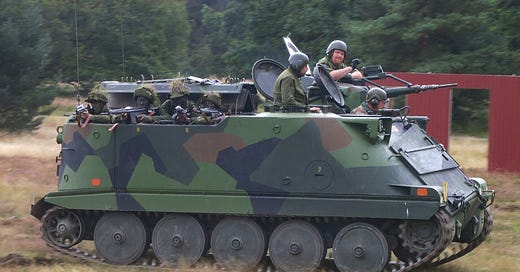Sweden Is Giving Ukraine Every PBV 302 Armored Personnel Carrier It Has. Potentially Hundreds of Them.
Ukrainian brigades are badly in need of APCs.
The massive, $1.25-billion aid package that Sweden pledged to Ukraine on Wednesday includes every single decommissioned Pansarbandvagn 302 armored personnel carrier the Swedish army still has in storage. Potentially more than 200 vehicles, according to the army.
This is a very big deal. With the passage of a new national mobilization law as well as other reforms, Ukraine is drafting and recruiting fresh troops—tens of thousands of them—and forming new brigades to grow its 100-brigade ground forces.
But absent the Swedish vehicles, there aren’t enough armored vehicles to ensure even half the new brigades are mechanized brigades. Instead, many of the new units were announced as infantry brigades whose heaviest vehicles might be civilian-style trucks.
This is a problem in a war where tiny explosive drones are everywhere. A two-pound first-person-view drone is a threat to an armored personnel carrier, but not an existential one. It’s possible for even a lightly-protected APC to shrug off FPV strikes and keep moving while also protecting its occupants.
But against exposed infantry traveling in unarmored vehicles—or worse, traveling on foot—FPVs are murder. It’s not for no reason that Russian casualties have spiked at the same time the Kremlin is struggling to generate adequate numbers of armored vehicles for its assault groups, and instead has begun equipping some groups with civilian-style vehicles including Chinese-made golf carts.
To avoid the same bloody fate as those unprotected Russian infantry, Ukrainian infantry need APCs. Sweden is answering that call. Those hundreds of PBV 302s will “support the reconstruction of new Ukrainian brigades,” wrote Pål Jonson, Sweden’s defense minister.
The PBV 302 is a 15-ton APC in the class of the American M-113 with space for 11 crew and passengers and protection against small-arms fire and artillery fragments. Swedish firm Hägglund & Söner produced around 650 copies between 1966 and 1971. In the 1990s, the Swedish army replaced the BV 302s with new CV90 infantry fighting vehicles.
Prior to the Ukraine, there were no export customers, meaning every PBV 302 that still is operable is a candidate for swift transfer to Ukrainian forces. The maximum possible quantity—more than 200 APCs—should be enough to equip at least two of the four new infantry brigades Kyiv is forming while potentially also restoring an existing mechanized brigade that recently downgraded to an infantry brigade owing to a shortage of APCs.
That would mean thousands of troops who no longer would have to ride into battle in trucks or march in on foot. With a single massive aid package, Sweden could save potentially hundreds of Ukrainian infantry from getting dismembered by Russian drones.
Read more:
The United States Has Given Ukraine a Hundred M-2 Bradley Fighting Vehicles in Just Two Weeks
In two weeks, the United States has shipped around 100 M-2 Bradley infantry fighting vehicles to Ukraine. That’s a lot of Bradleys: enough to replace all the 33-ton, 10-person M-2s the Ukrainian army’s 47th Mechanized Brigade—so far Ukraine’s only Bradley-operator—has lost in a year of non-stop combat in southern and eastern …






